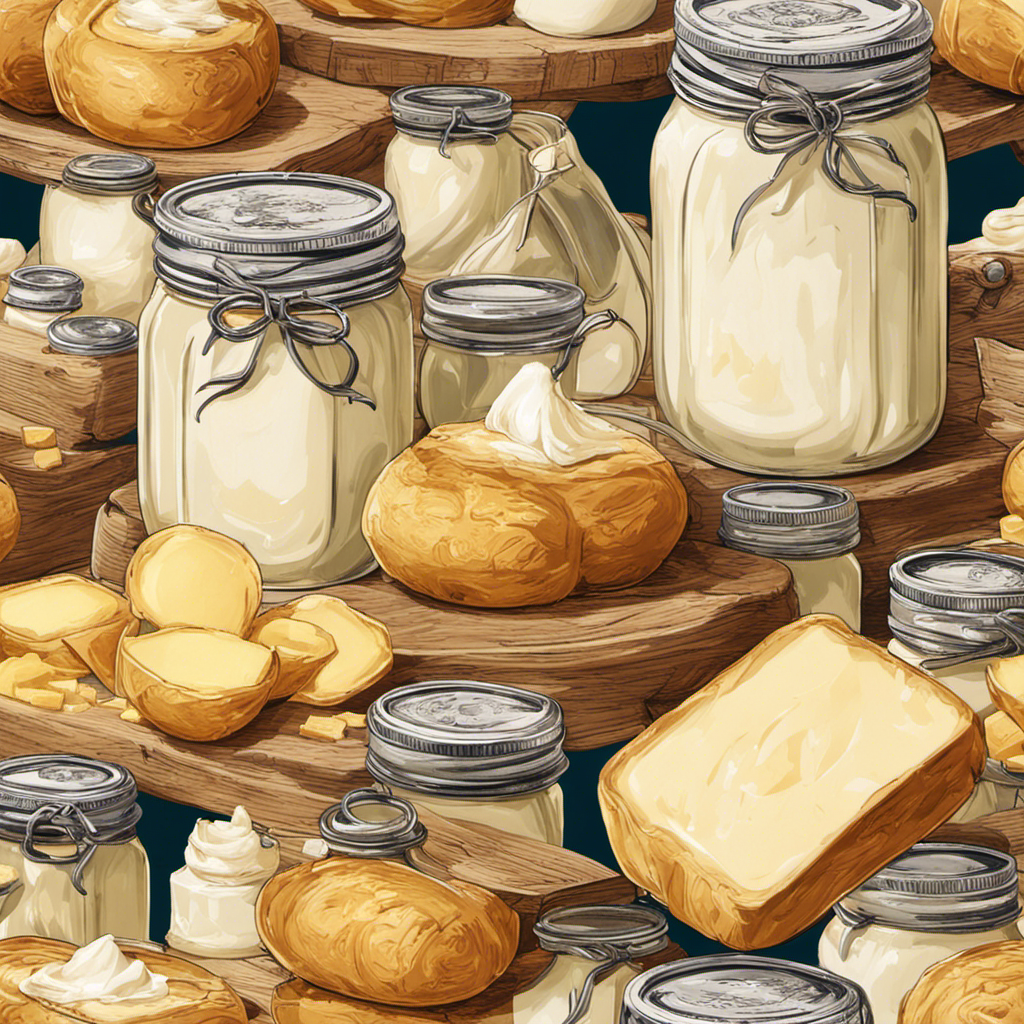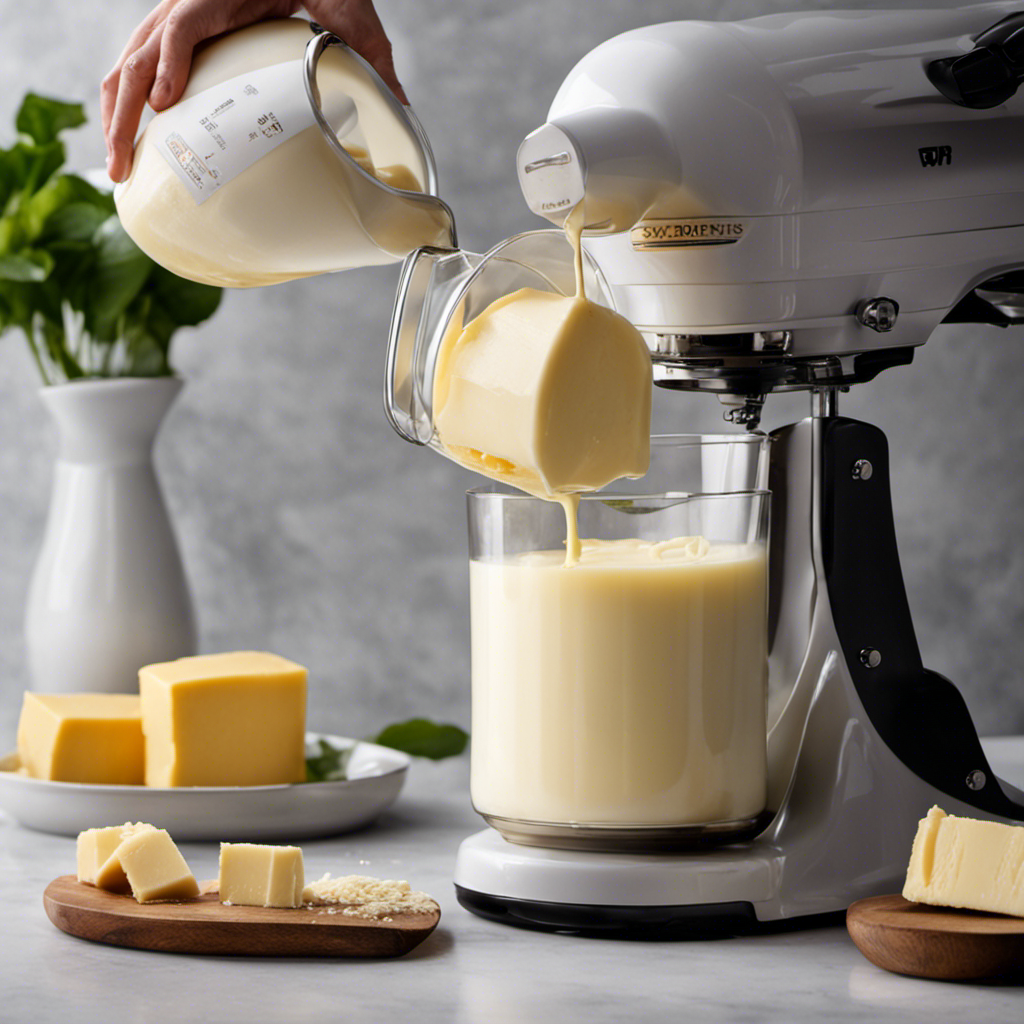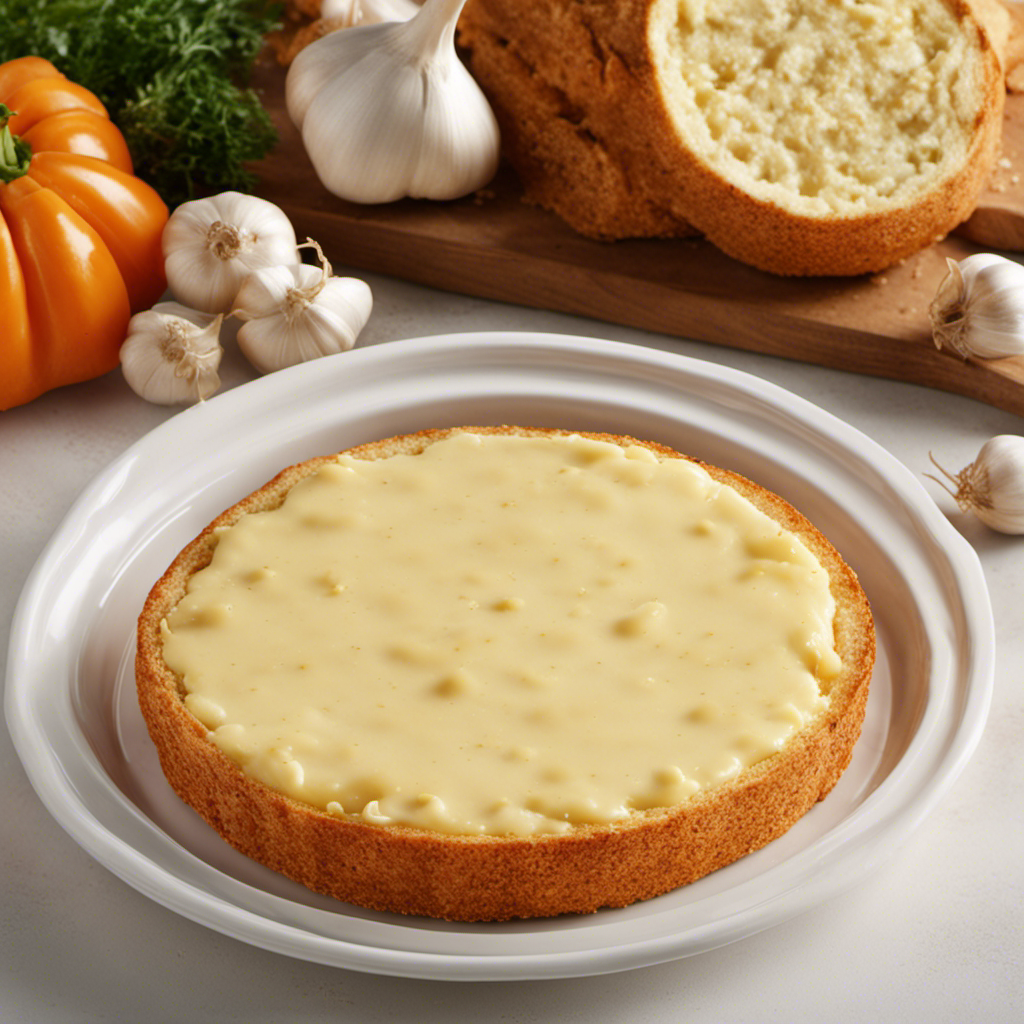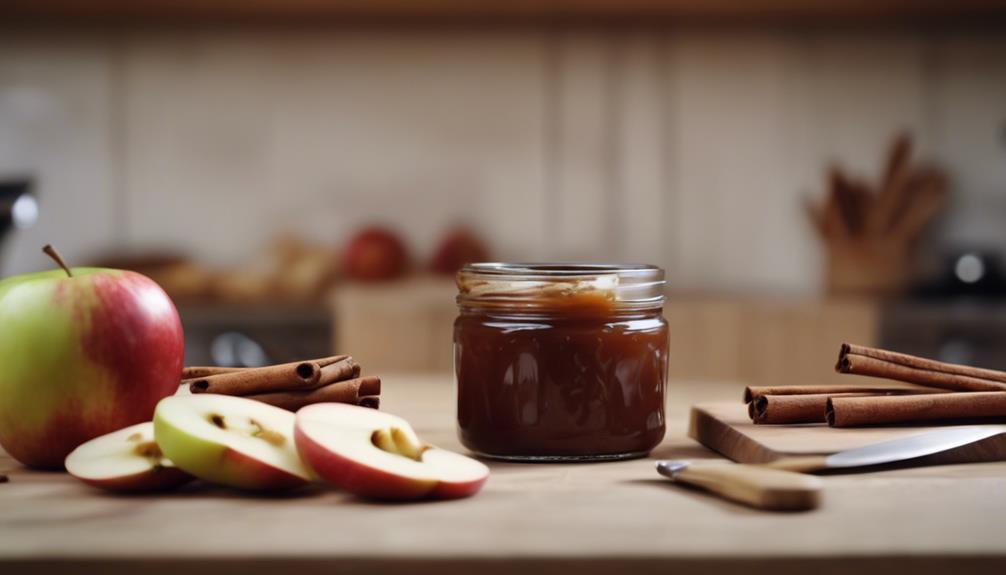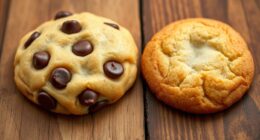Hey! Have you ever thought about how to turn raw milk into homemade butter? Look no further, I’ve got the solution for you.
In this article, I’ll take you through the step-by-step process of turning that creamy goodness into delicious homemade butter.
We’ll explore the benefits of using raw milk, learn how to separate the cream, and even discover different flavors you can infuse into your butter.
So, grab your apron and let’s get churning!
Key Takeaways
- Raw milk contains essential vitamins, minerals, and enzymes that are destroyed during pasteurization.
- Separating the cream from raw milk can be done through gravity separation, centrifugal separation, or cold separation.
- Churning the cream into butter can be done through hand churning, using a stand mixer with a whisk attachment, or using a food processor with a blade attachment.
- Washing and storing the freshly made butter involves cleaning the butter container and preserving its freshness by wrapping it tightly in wax paper or using an airtight container.
Understanding the Benefits of Raw Milk
Raw milk has numerous health benefits that are not found in pasteurized milk. Understanding the nutritional value of raw milk is important for those seeking a natural and wholesome source of nutrients.
Contrary to popular belief, raw milk is not a dangerous product when handled and consumed properly. In fact, it contains essential vitamins, minerals, and enzymes that are destroyed during the pasteurization process.
Raw milk is rich in beneficial bacteria and probiotics, which can support a healthy gut microbiome and enhance digestion. Additionally, raw milk is a good source of bioavailable nutrients such as calcium, protein, and healthy fats.
Debunking myths about raw milk is crucial to prevent misinformation and promote informed choices regarding our food.
Preparing the Raw Milk for Butter Making
To prepare the milk for butter making, it’s important to first skim off the cream. This step is crucial as it allows us to separate the high-fat cream from the milk, which is necessary for obtaining a good quality butter.
Here are three separating techniques to help you achieve the best results:
-
Gravity separation: After allowing the milk to stand undisturbed for a few hours, the cream naturally rises to the top, making it easy to skim off with a spoon or ladle.
-
Centrifugal separation: Using a cream separator machine, the milk is spun at high speeds, causing the heavier cream to separate from the lighter milk. This method is efficient and yields a higher cream quality.
-
Cold separation: By refrigerating the milk overnight, the cream becomes denser and easier to separate. Skimming off the cold cream results in a richer and creamier butter.
Separating the Cream From the Raw Milk
If you want to achieve the best results when separating the cream from the milk, try using gravity separation, centrifugal separation, or cold separation techniques.
Gravity separation involves allowing the milk to sit undisturbed in a container for a period of time, allowing the cream to rise to the top.
Centrifugal separation utilizes a machine that spins the milk at high speeds, forcing the cream to separate from the milk.
Cold separation involves chilling the milk to a low temperature, causing the cream to solidify and separate from the milk.
These techniques are beneficial because consuming raw dairy has numerous health benefits, such as improved digestion, increased nutrient absorption, and enhanced immune function.
Additionally, if you don’t have access to a churn, these separation methods provide alternatives for obtaining cream for making butter.
Churning the Cream Into Butter
Once the cream has separated from the milk, you can start churning it into delicious butter. Churning is the process of agitating the cream until it transforms into butter.
Here are three techniques to help you achieve the perfect consistency:
-
Hand Churning: This traditional method involves using a small churn or jar and physically shaking or rocking it back and forth until the cream turns into butter.
-
Stand Mixer: If you have a stand mixer with a whisk attachment, you can use it to churn the cream. Start at a low speed and gradually increase until the butter forms.
-
Food Processor: Another option is to use a food processor with a blade attachment. Pulse the cream until it separates into butter and buttermilk.
Troubleshooting common butter making problems:
- If the cream isn’t thickening, ensure it is at the right temperature (around 50-55°F) and give it more time to churn.
- If the butter is too soft, refrigerate it for a while before churning again.
- If the butter is too hard, let it soften at room temperature or add a small amount of buttermilk to adjust the consistency.
After churning the cream into butter, it’s time to move on to the next step of washing and storing the freshly made butter.
Washing and Storing the Freshly Made Butter
When it comes to washing and storing freshly made butter, there are a few key points to consider.
First, cleaning the butter container is essential to maintain the quality of the butter. I recommend using warm soapy water and a soft sponge to remove any residue before drying it thoroughly.
Second, preserving the butter’s freshness is crucial to prolong its shelf life. To do this, I suggest wrapping the butter tightly in wax paper or placing it in an airtight container to protect it from air and odors.
Lastly, it’s important to store butter at the proper temperature. The recommended storage temperature for butter is between 32-40°F (0-4°C), as this helps to maintain its texture and prevent spoilage.
Cleaning the Butter Container
Before cleaning the butter container, make sure to remove any leftover butter residue. Cleaning the butter container is essential to maintain its freshness and prevent any cross-contamination. Here are three effective cleaning techniques to ensure a clean and sanitized container:
-
Soak in hot, soapy water: Fill the container with hot water and add a few drops of dish soap. Let it sit for a few minutes to loosen any residue, then scrub with a sponge or brush.
-
Use vinegar solution: Mix equal parts white vinegar and water in the container. Let it sit for about 15 minutes to dissolve any stubborn residue. Scrub with a sponge or brush, then rinse thoroughly.
-
Bleach solution: Mix 1 tablespoon of bleach with 1 gallon of water. Let the container soak in the solution for 10 minutes, then scrub and rinse well.
Preserving Butter’s Freshness
After cleaning the butter container, the next step is to ensure that the butter stays fresh and maintains its texture for as long as possible. This is important because nobody wants to end up with rancid butter. To preserve the butter’s freshness, there are a few key things you can do. Firstly, storing the butter in an airtight container or wrapping it tightly in wax paper will help prevent it from being exposed to air and developing off flavors. Secondly, keeping the butter refrigerated at a consistent temperature, ideally around 40°F (4°C), will slow down the process of it going rancid. Lastly, if you want to store butter for an extended period of time, freezing it is a great option as it can extend its shelf life for several months. By following these steps, you can enjoy fresh and flavorful butter for all your culinary needs.
| Preserving Butter’s Freshness |
|---|
| Store butter in an airtight container or wrap tightly in wax paper. |
| Refrigerate butter at a consistent temperature of around 40°F (4°C). |
| Freeze butter for extended storage, which can extend its shelf life for several months. |
| Follow these steps to enjoy fresh and flavorful butter for all your culinary needs. |
Recommended Storage Temperature
Storing butter in the refrigerator at a consistent temperature of around 40°F (4°C) helps to maintain its freshness and prevent it from going rancid. Here are three recommended storage methods and the ideal temperature range for butter:
-
Wrap it properly: Use parchment paper or airtight containers to wrap the butter. This will protect it from absorbing odors and prevent it from drying out.
-
Keep it away from light: Exposure to light can cause butter to spoil faster. Store it in a cool, dark place, like the refrigerator’s butter compartment or a covered butter dish.
-
Avoid temperature fluctuations: Butter can easily absorb flavors and odors from other foods in the fridge. To maintain its quality, store it away from strong-smelling foods and make sure the temperature remains constant.
Following these recommended storage methods and keeping the butter at the ideal temperature range will help to preserve its freshness and taste for longer periods.
Using Leftover Buttermilk in Recipes
You can easily use leftover buttermilk in recipes to add a tangy flavor. Buttermilk is a versatile ingredient that can enhance the taste and texture of various baked goods. It’s a great substitute for regular milk in recipes because it adds a unique tanginess and richness. Here are some creative uses for leftover buttermilk in baking:
| Row | Buttermilk | Recipe | Result |
| 1 | Pancakes | Fluffy and | Light and |
| tender texture | fluffy pancakes | ||
| 2 | Biscuits | Tender and | Flaky and |
| flaky texture | buttery biscuits | ||
| 3 | Cakes | Moist and | Moist and |
| tender texture | tender cakes | ||
| 4 | Fried chicken | Crispy and | Juicy and |
| flavorful coating | flavorful chicken |
Exploring Variations and Flavors in Homemade Butter
When it comes to homemade butter, there are endless possibilities for adding unique flavors and enhancing its taste.
One way to do this is through unique butter infusions, where you can mix in various ingredients like garlic, herbs, or even fruit zest to create a personalized flavor profile.
Another option is to enhance the taste of your homemade butter by incorporating herbs such as rosemary, thyme, or basil, which can add a delightful aroma and taste.
Lastly, experimenting with flavored salts like smoked sea salt or truffle salt can take your butter to a whole new level, adding a burst of flavor that will elevate any dish.
Unique Butter Infusions
To add unique flavors to your butter, try infusing it with herbs or spices. Butter infusion techniques offer a creative way to elevate the taste of your homemade butter. Here are three ideas to get you started:
-
Garlic and Herb Butter: Melt your butter, then add minced garlic and chopped fresh herbs like rosemary, thyme, or parsley. Let the flavors infuse for a few hours before refrigerating.
-
Citrus Zest Butter: Grate the zest of an orange, lemon, or lime into your softened butter. Mix well and let it sit in the fridge for a while to let the citrus flavors infuse.
-
Spiced Butter: Add a pinch of your favorite spices, such as cinnamon, nutmeg, or cardamom, to your softened butter. Mix thoroughly and let it sit in the fridge to develop the flavors.
Enhancing Taste With Herbs
Adding herbs to your butter is a simple and effective way to enhance the taste of your culinary creations. Not only does it add a burst of flavor, but it also adds a touch of freshness and complexity to your dishes. Experimenting with different herbal blends can elevate your butter to a whole new level. Whether you prefer a savory blend of rosemary and thyme or a more exotic combination of cilantro and lime, the possibilities are endless. To help you get started, here is a table showcasing some popular herb and spice combinations that you can try in your butter:
| Herb/Spice | Flavor Profile | Best Pairings |
|---|---|---|
| Rosemary | Earthy, piney | Potatoes, lamb |
| Basil | Sweet, peppery | Tomatoes, mozzarella |
| Dill | Fresh, tangy | Fish, cucumbers |
| Cinnamon | Warm, sweet | Apples, baked goods |
Experimenting With Flavored Salts
After experimenting with herbs to enhance the taste of my homemade butter, I decided to take my flavor exploration to the next level by experimenting with flavored salts. Flavored salts can add a unique and exciting twist to butter, elevating its taste and making it even more delicious.
Here are three ways I incorporated different salts into my flavored butter recipes:
-
Smoked Salt Butter: I mixed smoked salt into softened butter, creating a smoky and savory spread that pairs perfectly with grilled meats and vegetables.
-
Truffle Salt Butter: By combining truffle salt with butter, I created a luxurious and indulgent spread that adds a hint of earthy and aromatic flavor to any dish.
-
Citrus Salt Butter: I zested some fresh citrus fruits and mixed the zest with sea salt before incorporating it into butter. The result was a bright and tangy butter that adds a burst of freshness to baked goods and seafood.
Frequently Asked Questions
Can I Make Butter From Pasteurized Milk?
Yes, you can make butter from pasteurized milk. It’s a simple process of churning the cream until it separates into butter and buttermilk. Homemade butter can be healthier than store-bought due to its freshness and lack of additives.
How Long Does It Take to Separate the Cream From the Raw Milk?
Separating cream from raw milk depends on various factors, such as temperature and milk fat content. Once separated, the cream can be churned into butter. The churning process can take anywhere from 10 to 30 minutes.
Can I Use an Electric Mixer Instead of a Churn to Make Butter?
Yes, you can use an electric mixer to make butter. However, it’s important to note that the process may differ slightly between churning raw milk and pasteurized milk.
How Long Can I Store Freshly Made Butter?
Freshly made butter can be stored in the refrigerator for up to two weeks. However, its shelf life can be extended by freezing it. Proper storage is essential to maintain its freshness and quality.
What Other Uses Are There for Leftover Buttermilk Besides Using It in Recipes?
Leftover buttermilk can be used in pancakes, biscuits, or even as a marinade for fried chicken. As for alternative methods for making butter, you can also use heavy cream and a mixer.
Conclusion
In conclusion, making butter from raw milk is a delightful and rewarding process. The benefits of raw milk are numerous, as it contains valuable enzymes and nutrients that are lost during pasteurization.
By separating the cream from the raw milk and churning it vigorously, you can easily transform it into creamy and delicious homemade butter.
Don’t forget to wash and store the butter properly to ensure its freshness. And don’t discard the leftover buttermilk! It can be used in various recipes to add flavor and moisture.
So, grab some raw milk and start your butter-making adventure today!
